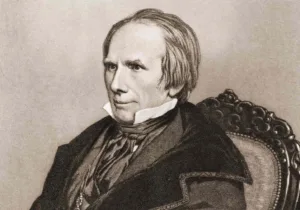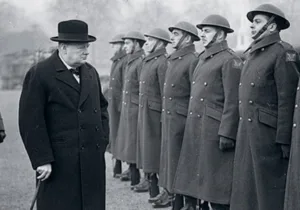This article, delineating the two kinds of freedom found in the tradition of Western civilization, was originally published in Christianity and Crisis on October 19th, 1942. Editor Henry P. Van Dusen clarifies the two strands of freedom that have developed in European thought. One comes from the Protestant Reformation, a freedom that comes as a result of being created in God’s image and the rights that entail; the other comes from the Enlightenment, a freedom that is intrinsic to man’s nature and “self-evident,” something that is somehow apparent to all. Van Dusen explains the heritage and intellectual tradition of both freedoms, and suggests that their influences might explain the different responses from their respective lands of origin during the Nazi occupation. To read the original article in PDF format, click here.
Some months ago a proposal, emanating from Washington and presumably with Presidential approval, sought to launch a nation-wide competition to discover the most appropriate name for this war. A vast collection of varied suggestions were forthcoming. The proposal was abortive. The President himself had forged the slogan by which the war is to be known. This is the War for Freedom.
In this day when “freedom” is the most universally accepted battle-cry in a struggle for the preservation of civilization, it is important for Americans to recall that not one but two main traditions of “freedom” stand in their background and have woven themselves into the fabric of national consciousness. They are drawn from very different spindles and are of sharply contrasted textures.
One dates from the sixteenth and seventeenth centuries, the other mainly from the eighteenth and nineteenth. One stems from the Protestant Reformation with its insistence upon the worth of the soul of man as a child of God, the other from Modern Romanticism and Naturalism with its demand for the rights of man as a child of nature. One had its formulation in the Christian Humanism of Erasmus, Thomas More and Colet, and the stern Puritanism of William of Orange and Cromwell ; the other, in the puerile Utopianism of Rousseau and the soured cynicism of Voltaire. One rallied its defenders with Luther’s manifesto : “The Christian man is the most free lord of all, and subject to none. The Christian man is the most dutiful servant of all, and subject to every one.” The other rallied with the slogan of the Revolution, “Liberté, Égalité, Eraternité.” One spoke of a freedom of privilege and obligation; the other proclaimed a freedom of claims and self-assertion. One was nurtured in a land which offered refuge to Spinoza and his kinsfolk; the other spawned amid the excesses of the guillotine.
Both traditions made their way across the Atlantic and found fertile seed plots in the ample spaciousness of a new continent—but in very different degrees and circumstances. From the country of Spinoza and Erasmus came Pilgrims to Plymouth to initiate a New England tradition of piety and industry, and shortly after, Hollanders with a small group of enterprising Jews to establish the staid solidity of New Netherlands in the New World. It was a century and more later before the younger cult of “freedom” began to sow its intoxication in the imaginations of Americans through a flaming literature and the fluent charms of apostles of the new man.
Both traditions laid hold upon the minds of the Founding Fathers, and wove their substance into the founding literature of the new nation. Those early decades witnessed not one but two struggles over freedom. First, there was the common struggle against the oppressor in which all lovers of freedom joined forces to win independence so that liberty could be established; and then came an internal struggle to determine the character of the liberty which was to be established and the principles and structures by which it was to be made secure. The great Declaration spoke the accents of one tradition with its proud and moving recital of self-evident truths concerning the natural man-truths which were by no means self-evident. But the instrument which was to form and mould the government of the new commonwealth adhered to the insights of the older and more somber tradition with its shrewd provision of checks and balances against the license of the natural man. Our schoolbooks do not sufficiently instruct American youth in the contrast between the two great documents of our heritage. Both are truly documents of freedom. But they proceed from quite different presuppositions. Basically they rest on almost antipodal views of man. In the Declaration of Independence, Jefferson voiced the faith of the age of Romanticism and Revolution in whose dreams and hopes he was so sympathetic a participant. Into the Constitution the pen of James Madison wrote rigorous safeguards for the hard-won freedoms of men, which he had come to recognize as necessary under the stern Calvinist tutelage of old John Witherspoon.
The two traditions of freedom have continued in tension or unstable equilibrium through succeeding decades, not merely in the United States but in the Western World. The history of western Europe in the nineteenth century is, from one perspective, a struggle between two conceptions of freedom stemming respectively from the Reformation and Christian Humanism on the one hand, and Romanticism and the French Revolution on the other. While no nation has been wholly free from both influences or has exhibited either influence alone, it was only natural that the two countries which so largely cradled the contrasted movements at their rise, Holland and France, should most fully reveal the logic of their later development. The respective heritages have reemerged as each nation has been driven back upon the deeper foundations of national life in the present crisis. This cannot wholly explain the contrast between Holland and France under the humiliations of 1940. But may it not be some part of the explanation of that contrast?
In any event, the secret of Holland’s amazing resistance against the subjugation of man and in defense of the Jewish race is clear. It represents the rebirth of a Church and also the spiritual revitalization of a populace. It has been accomplished largely by a return to and reclamation of the original sources of Dutch Protestantism which were also the tap-roots of the Dutch people. It was as a part of the Protestant Reformation that the Dutch nation was born. Two slogans dominated the Eighty Years’ War for Dutch freedom: “For the sake of Religion” and “For the sake of Liberty.” A leading Dutch Christian emphasizes, “Today, as in the sixteenth century, liberty means above all spiritual liberty, and the fight for the nation is above all a fight for the soul of the nation.”
At a time when “freedom” is cried from every skyscraper-top and bandied by every super-patriot, those who care deeply for the future of humanity do well to disentangle the strands in the motley garment of modern liberty, to know the bases of the only liberty which can steel devotion to the uttermost, to take firm grip on the tradition of Christian freedom, and to stand fast in the liberty of the sons of God.
H. P. V. D.
—
Photo Credit: Martin Luther burns the Papal bull in the square of Wittenberg in the year 1520. Source: Oil on canvas by Karl Aspelin (1857-1922) (via Wikimedia Commons).






 Sponsor a student for Christianity & National Security 2024
Sponsor a student for Christianity & National Security 2024